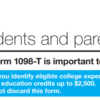Tax season is once again upon us. According to the Internal Revenue Service (IRS), the 2024 tax filing period officially kicks off on Monday, January 29th. There’s no time to lose; many students and their family members are already getting ready to file their annual returns.
But not many realize that students enrolled in higher education are often eligible for a surprising amount of money in tax credits and benefits. This is real money that will lower the taxes they pay and will often get refunded directly to their bank accounts. The funds are crucial to student basic needs security.
For example, the American Opportunity Tax Credit (AOTC) could give a U.S. citizen or resident enrolled in college up to $2,500 each year—money that they can use to help pay for tuition, food, housing, health care, and more. (Another education credit, the Lifetime Learning Credit, works similarly to the AOTC.)
A student who works part or full time but earns less than about $63,400 per year—an amount that few college students realistically exceed—could also qualify for the Earned Income Tax Credit (EITC) of nearly $4,000 to help subsidize their income. A parenting student with dependents might get another $2,000 from the Child Tax Credit (CTC). These benefits can quickly add up.
But there’s a catch: you have to file taxes to get these benefits.
Many students and their families don’t file taxes at all because they aren’t required to file, are confused about how to file, or miss the tax-filing deadline. If these taxpayers were aware of the potential benefits and did file, they could benefit substantially.
Take the following example of a parenting student with one child who is working part time in a low-wage job. They could receive the following:
Tax Benefit | Amount |
American Opportunity Tax Credit (AOTC) | $2,500 |
Child Tax Credit (CTC) | $2,000 |
Earned Income Tax Credit (EITC) | $3,995 |
Free tax filing | Free |
TOTAL BENEFITS | $8,495 |
That means this student could have more money shaved off their tax bill this year than the value of the maximum federal Pell Grant, which currently clocks in at $7,395. In total, more than $27 billion in higher education tax benefits are given out to taxpayers each year—compared to about $29 billion in Pell Grant funding.
While not all the tax credits are fully “refundable” (meaning they can go back into your pocket or bank account even if you owe no taxes), a substantial portion can be. Up to $1,000 of the AOTC is refundable, up to $1,500 of the CTC is refundable, and the entire $3,995 of the maximum EITC is refundable—meaning this example single parent in school could get $6,495 deposited directly in their bank account to help them with food, housing, and child care.
What Students Can Do to Claim Tax Benefits
For students, the advice is straightforward—if you’re a U.S. citizen with a Social Security Number: file taxes every year, even if you’re not required to. Doing so will unlock potentially thousands of dollars in tax credits and benefits that could be refunded back to you. Filing taxes rarely has any downside, and you are not likely to owe any more money to the federal government. The vast majority of employers today already withhold taxes from your paycheck. (The exception might be if you were an independent contractor, for example).
If you’re close to your family or they support you financially, consider encouraging them to file taxes, too. If your parent claims you as a dependent on their tax return, they can receive the education credit like the AOTC.
Make sure to wait for your tax form 1098-T to arrive from your college before filing. This form reflects any tuition and fees (and some course materials) that you paid to your school. Nearly every student (or their family) that has a Social Security Number or Individual Taxpayer Identification Number (ITIN) will receive this form for every year you were enrolled in college.

Example Form 1098-T that students will receive from their institution. These forms are required to file for education credits but rarely include information about how students can file taxes for free.
While the forms don’t often contain instructions on how to file taxes, they’re the key to getting the education tax credits like AOTC.
For many taxpayers, filing taxes is completely free. Most tax filing software, such as H&R Block, TurboTax, and others will help you claim the education credits. Those who prefer to speak to a tax professional in person and make less than $60,000 per year can check out a Volunteer Income Tax Assistance (VITA) location and get free help filing taxes. The IRS is also piloting a new program to allow certain taxpayers to file their tax returns directly for free, but it doesn’t yet include the education credits – hopefully, it will next year.
When you submit a tax return, it’s important that you don’t sign up for gimmicks or scams. You should avoid putting any tax refund on a gift card or prepaid card (like an Amazon gift card) and instead use direct deposit to your bank account. If you don’t have a bank account, set up an account with low fees. Because some college-branded accounts and cards come with high fees, it may be a better idea to set up a bank account on your own rather than through your college.
How Colleges Can Get the Word Out to Students
Colleges and universities bear some responsibility to get the word out. Institutions of higher education are required to send out 1098-T forms to students during tax season.
Unfortunately, most institutions of higher education that send out these tax forms to students don’t include instructions on what to do with them. They send the forms without information about how tax filing could yield significant financial benefits. So, students receive a complicated-looking form and frequently leave it on read.
If colleges sent actionable information to students along with their 1098-T that describes the potential benefits of filing taxes, millions of students and their families could receive financial benefits. This could lower basic needs insecurity.
A study of outreach to individuals who might be eligible for tax benefits found that getting people to file tax returns could give them substantial financial benefits. Among 5 million people who are likely eligible for the EITC, approximately two-thirds do not file a tax return. A 2017 study found that sending targeted information about education tax benefits was helpful for many subgroups of students.
Institutions of higher education are also permitted to use data from the Free Application for Federal Student Aid (FAFSA) to encourage students to claim tax benefits they might be eligible for. Thanks to the FAFSA Simplification Act, institutions of higher education will soon be receiving information for the first time on which FAFSA filers for 2024-25 are receiving EITC and/or premium tax credits for health coverage under the Affordable Care Act. They can reach out to any students or families that are not receiving those benefits to encourage them to apply.
Colleges and universities that want to help students and their families afford college, stay enrolled, and reduce their student debt should send out information to students about tax credits and remind them to file taxes to get these benefits.
How Policymakers Should Help Students
The U.S. Department of Education and the IRS should team up to issue guidance to colleges that encourages them to spread the word about tax benefits in financial aid award letters, when they send out 1098-T forms, and throughout the tax filing season. Each year, these federal agencies should also ensure that colleges have the latest information about the tax credit amounts and qualifications and encourage them to provide information directly to students.
Currently, students who fill out the Free Application for Federal Student Aid (FAFSA) don’t receive any specific information about the tax benefits they’re eligible for—only a general link to the IRS website. The FAFSA Submission Summary and follow-up emails to applicants should include specific information about tax benefits. Recently, the IRS announced it would be sending more and simpler notices to taxpayers about the credits and deductions they claim, and students should get more information about the credits they could receive.
Congress has a role to play, too. The portion of grants and scholarships that students spend on non-tuition expenses like food, housing, and child care is sometimes treated like “income” for tax purposes. This makes the tax code unnecessarily complicated. For students who work, it can result in a larger tax burden, and the policy is counterproductive to efforts to boost the Pell Grant and other federal, state, and institutional aid. Congress should fully exclude financial aid from taxes by passing the Tax-Free Pell Grant Act.
On a longer-term basis, Congress should simplify and consolidate the education tax benefits, as a bipartisan 2013 proposal would have done—and consider moving all of this spending toward Pell Grants and other upfront aid which is shown to have a much more significant effect on college enrollment.
Together, higher education institutions and policymakers can help students and their families better afford college costs and meet their basic needs by ensuring they get the tax benefits they are eligible for.

Additional Resources
Find more financial tips on our resources page.
See if you qualify for an education credit.
See if you qualify for the Child Tax Credit.
See if you qualify for the Earned Income Tax Credit.


